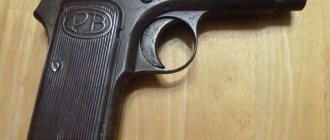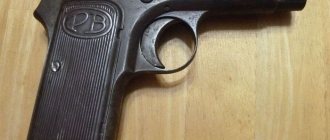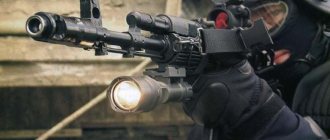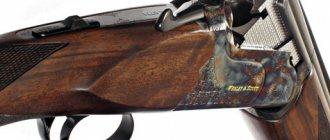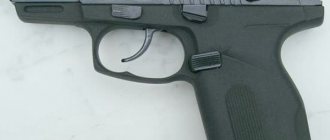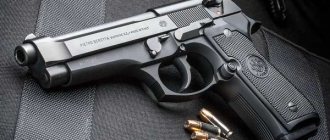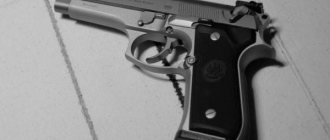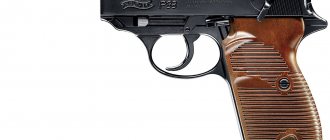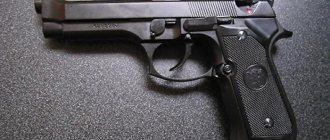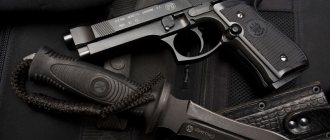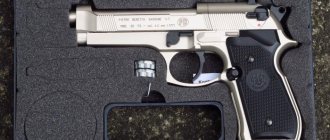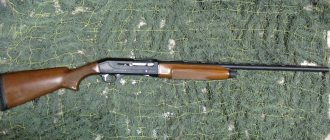In May 1915, Italy enters the First World War. In the first months, there is a need for reliable close combat weapons - pistols. The Glisenti M 1910 pistol, similar to the German parabellum, did not satisfy this need. Then Pietro Beretta comes onto the scene with its own take on the design of a pistol.
This is the look of the 9 mm M1915 model, which quickly replaced all analogues and won a place in the holster of the Italian army. The accuracy and reliability of the new weapon, which made history at the right moment, ensured the future of Beretta pistols for a long time.
Thus began the history of the family of Italian self-loading pistols, which has continued for more than a hundred years.
One Hundred Years of History
1915–1951
Model M1915 was chambered for 9x19 mm Glisenti caliber. Two years later, a lightweight M1917 of a weaker caliber appeared, with a 7.65x17 mm Browning cartridge. In 1923, the 9x19mm Glisenti became the main cartridge. In the same year, Pietro Beretta released a new prototype - Beretta M1923 for this cartridge.
This model was in service until 1935, and in minor roles until 1945.
It was characterized by low reliability and less destructive power compared to pistols for 9x19 Parabellum. Production ceased in 1925.
The Beretta M1934 replaced its outdated predecessors in 1935. It was produced in 9 mm (Corto) and 7.65 mm cartridges. The 7.65 model lasted in production from 1935 to 1991.
In fact, production ended in 1980, but in 1991 a collector's batch of these weapons was released. It entered service with the Third Reich under the name Pistole 671. It was used by officers of Romania and Finland during World War II.
1951–1980
The M1934/1935 is being replaced by the Beretta M1951 with the Parabellum 9 mm caliber, the development of which began in the 40s.
The creation of the pistol was led by the need to standardize NATO weapons and the ability to use submachine gun cartridges. Production from 1953 to 1980.
Due to its large mass (870 grams without magazine), the weapon quickly returned to the aiming line after recoil. Convenient to use.
For the first time, the weapon shows Italian design, compared to the boring and unremarkable previous designs.
In the mid-70s, Italian craftsmen took all the best from the previous family of pistols and created a new weapon - the Beretta 92.
For the first time, the index 92 does not indicate the year of production: 92 is 9 mm, 2nd model. Apparently, the first model was being developed, which did not suit its creators.
Produced from '75 to '80. The modification came off the assembly line in quantities of 5 thousand pieces, using the same 9 mm parabellums.
A plant was built in Brazil to manufacture this model, which was later sold to Taurus.
After this, the production of weapons began under the name PT 92. In turn, the Beretta 92 and PT 92 models had a lot in common in appearance, but were structurally different.
Taurus also released a wide range of pistols under the PT brand.
1980–today
In the late 70s, the Beretta 92S completely replaced the original 92 version. This pistol met the wishes of the Italian police for service equipment.
From 1978 to 1984, Pietro Beretta took part in an American tender for a company that would supply new pistols to the US Army.
In addition to the Italian manufacturer, Americans, Germans, Spaniards, Belgians and Swiss participated.
The leading pistols were the Beretta 92F and the Swiss Sig Sauer P226. Beretta won this competition, surpassing its competitor in the purchase price.
And according to the unofficial version, for political reasons between Italy and the United States, perhaps for granting the right to deploy bases and missile defense on their territory.
One way or another, the company received the first contract for 500,000 weapons under the M9 brand (Beretta 92F). The production of weapons began at its own branch in the USA, Maryland.
From the 80s to this day, the manufacturer has been producing a wide range of pistols in the 92 line.
The past is the future
The Beretta concern has its own museum. There are one and a half thousand weapons on display, and more than four thousand in its storerooms. All of these exhibits have their own uniqueness in design or execution. This museum has a lot to do with the future, no matter how strange it may sound. The samples stored in it are examined for design advantages, and based on this, samples of future models are developed.
Beretta still creates museum pieces today. This is done by the “masters’ workshop”, which consists of divisions that make the main parts for the guns, fitting them to each other, and an engraving workshop.
Now Beretta has begun producing an exact copy of a capsule shotgun for true connoisseurs of hunting with antique guns - “Replica 1000”.
There is not a single drop of doubt that Beretta is a forge of masterpieces of art, which can itself store, restore and increase its exhibitions.
Design features of the Beretta 92
The safety lever is double-sided and is located on the bolt cover. Turned on with your thumbs by turning the flag down.
The included safety does not block the bolt, which allows you to safely reload the weapon. When the safety is turned on, the trigger is disconnected from the trigger rod - that is, it becomes uncocked.
You don't have to cock the hammer before firing, but you will need to put more force on the trigger than when it was cocked. This is called self-cocking.
There is a jumper between the cartridge primer and the firing pin, which prevents a shot until the last phase of the trigger movement. Immediately before the shot, this jumper rises.
After the clip is used up, the bolt casing is retracted and locked in this position. When a full magazine is loaded, the bolt automatically fires a cartridge into the chamber.
Modifications based on the Beretta 92
- Beretta 92S modified for the needs of the Italian police. The safety has also been modified for the role of a safe release of the trigger (release without firing a shot on the safety). Today, clips suitable for this model are produced. Produced since 1976. Currently out of print;
- The Beretta 92SB is a continuation of the previous model. The main differences are the double-sided safety and automatic firing pin locking. Magazine for 15 rounds. Produced from 1981 to 1991;
- The Beretta 92F appeared to participate in the XM9 tender, as a replacement for the main pistol of the US armed forces. After the victory, production began under the designation M9. Produced since 1984;
- The Beretta 92G Gendarmerie is produced in France under the designation PAMAS G1. The appearance is due to the replacement of outdated pistols for the needs of French police. Produced since 1987;
- Beretta 92FS is a modification of the American 92F. Put into production to eliminate errors of the previous model 92F, based on the combat experience of the American military: the bolt was sometimes destroyed during use. Produced since 1989 (for American aircraft under the name M9);
- Beretta 92D without safety. Produced since 1990;
- Beretta 96 is a modification of the 92F chambered for the common American .40 SW cartridge. Used by US police and border guards, popular among civilians. Magazine for 11 rounds. Produced since 1992;
- Beretta 96 Brigadier - modification 92FS chambered for .40 SW with a reinforced bolt, removable front sight. Produced since 1996;
- Beretta 92FS Centurion. Double-row magazine for 15 rounds. Shortened, both the barrel and the bolt are on an unchanged frame. Produced since 1996;
- The Beretta 92 Vertec was originally intended for US police. Changes to the handle to make it easier for a larger person to hold. Mount for laser laser or flashlight. Produced since 2003;
- The Beretta 90 Two is the latest example in the 92 line. It has the ability to use an under-barrel flashlight or a laser target designator. Futuristic design solutions have been introduced to the exterior. Produced since 2006.
In addition to these samples, there is the Beretta 98 line (7.65x21 mm Parabellum) and its variants chambered for 9x21 mm IMI cartridges. This line is for countries, mainly European, where military calibers are prohibited for civilian use.
Production of hunting weapons "Beretta"
In the middle of the 17th century, Beretta was already in first place among the leading arms manufacturers in Italy. The company specialized in the production of military weapons. At the beginning of the 18th century, with the arrival of new management, it was decided to start producing hunting rifles, and in 1719 they became the largest in this niche.
At the beginning of the 19th century, the Republic of Venice came into the possession of France. These years remained in history as the bloody campaigns of Napoleon Bonaparte, and Beretta received a huge order, thereby making a good profit, which contributed to the further development of the enterprise.
In 1903, thanks to Pietro Beretta, a major modernization took place. A state testing station appeared at the plant, and new models of hunting rifles were developed.
In 1977, on the twenty-fifth anniversary of Elizabeth II’s ascension to the throne, Beretta completed an order for a double-barreled vertical shotgun as a gift. Thus, securing the right to be called the first in the Old World.
Pros Cons
Advantages:
- Large balanced weight from 870 to 950 grams (up to 1000) leads to a quick return to the line of sight;
- The increased distance between the front sight and the sight makes aiming easier;
- The fuse box is located on both sides;
- “Licked” structural elements do not cling when pulled out.
Flaws:
- The immodest size makes concealed carry difficult;
- Firing high power cartridges reduces durability;
- The bulky handle is inconvenient for a person with small palms and fingers.
Since the pistol’s feature is an open bolt with a view of the barrel, the following disadvantages arise:
- Possibility of getting burned by a hot barrel;
- Increased contamination of the internal parts of the gun.
Today the Pietro Beretta company is called Fabbrica d'Armi Pietro Beretta Gardone and is not going to give up its place in the arms market, including pistols. The BU-9 Nano, an extremely compact concealed carry pistol, was recently released.
The latest development that has already appeared on the market is the Beretta APX multi-caliber pistol. The Beretta story definitely won’t end there, we’ll wait and see.
Beretta shotgun
When developing new products, it is important to combine modern design, age-old traditions and functionality. It is also necessary to observe the main characteristics of smooth-bore guns - accuracy, sharpness and scree. Compliance with all these requirements poses difficult challenges for developers. When all the components come together and the new product is truly unique, do not skimp on presentation. In different countries, agreements are concluded with eminent figures, who, in turn, represent this product on the market.
To improve the characteristics of the scree and reduce the recoil on the shoulder, changes are made to the drilling of the barrel. For example, the Optima-Bore HP drill type has an extended projectile exit. To reduce barrel bounce when firing, an oil-filled Kick-Off shock absorber has been developed. In order to increase the service life of the barrel, chrome plating is used on both the barrel and the chamber. It also increases the speed of the projectile.
